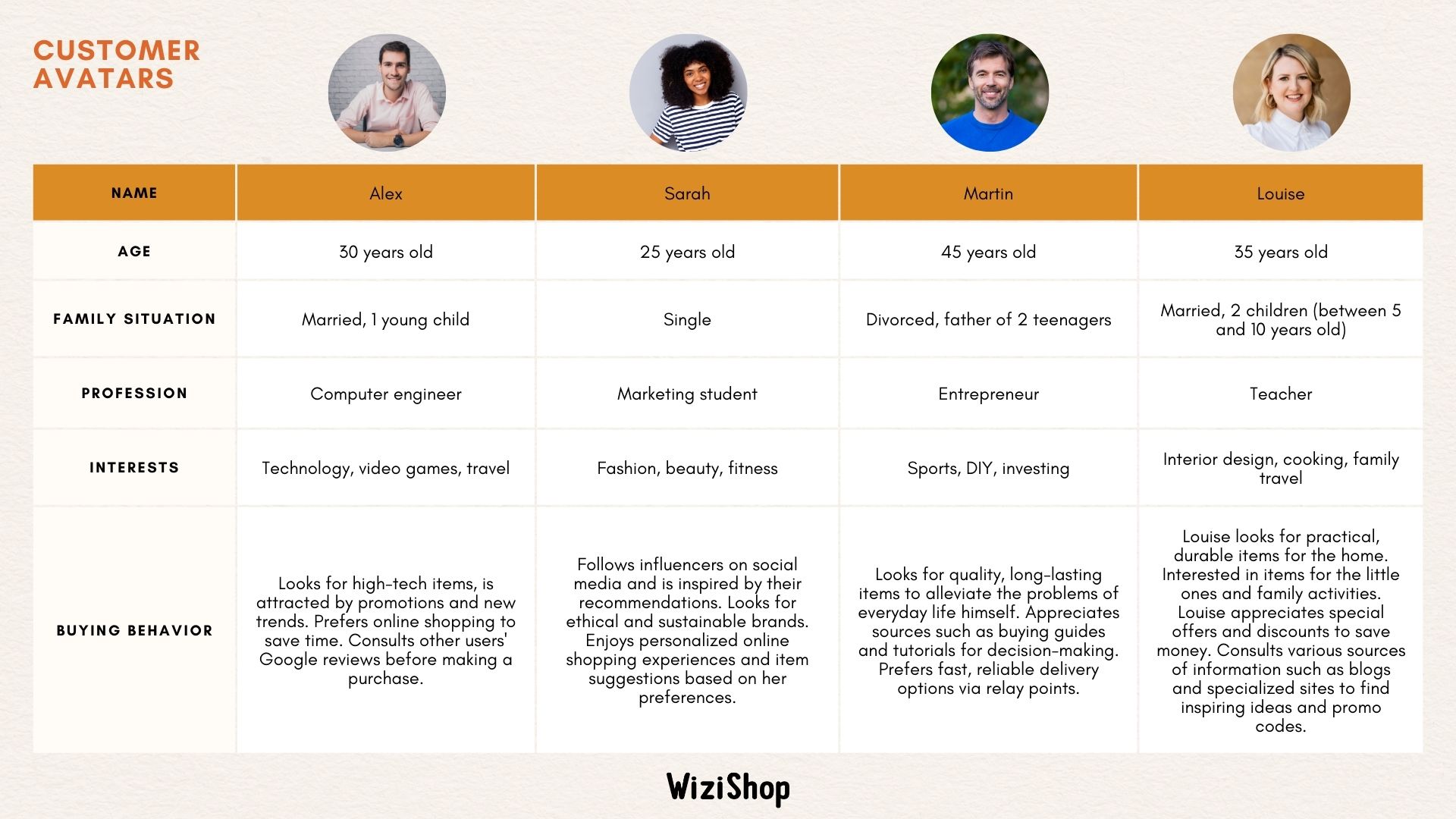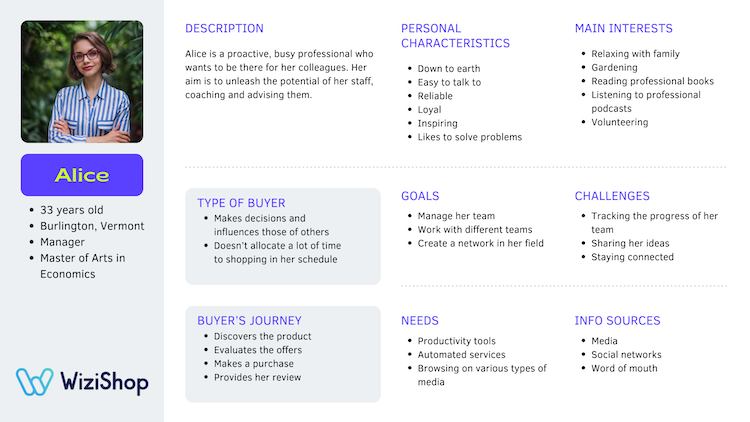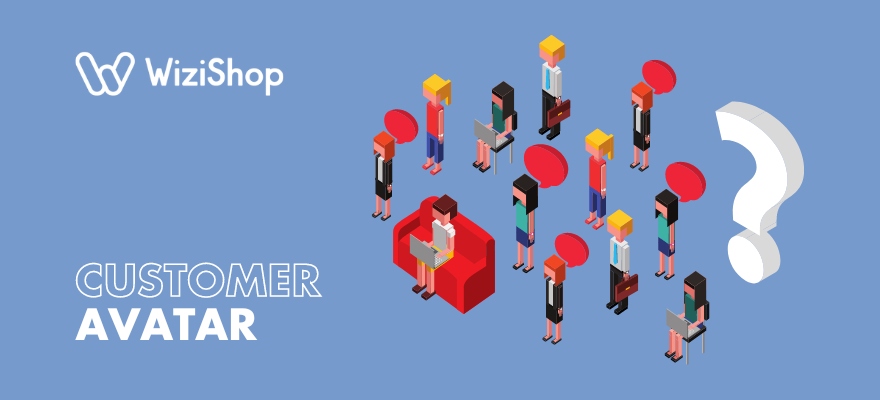In any marketing strategy, personalized content is very important. These days, customers are inundated with commercial messages.
In this context, personalization is the best way to stand out from the crowd. In fact, according to a study by Marketing Inside Group, 78% of internet users say that personalized communication increases their desire to buy.
However, to address your target audience correctly, you need to know them inside out. For this, there's an unbeatable method: the customer avatar.
So, what exactly is the customer avatar, and how can it be used to good effect?
Definition of the concept and recurring questions
First of all, let's take a moment to lay the foundations and explain the basics of the customer avatar concept.
What is a customer avatar?
A customer avatar is also known as a "persona" or "buyer persona". In a way, it's a portrait of your target. So, like a real person, a customer avatar must have a first name, an age, a place to live, interests, hobbies, a family background, etc. It also has desires, obstacles, dreams, fears, and motives.
When we design a customer avatar, all these elements are brought together in a descriptive worksheet. This includes demographic, economic, geographic, and psychological information.
The aim of a customer avatar is to help you get to know your contacts perfectly, sometimes better than they know themselves!
Why create a customer avatar?
Creating a persona is a popular part of today's marketing strategy quite simply because it can offer you a number of commercial and competitive advantages:
- Know where your customers are: knowing your avatar lets you know where your customers are and how to contact them. It's an unbeatable way to avoid spreading yourself too thin in your communications strategy.
- Create the ideal offer: once you know your customers' issues and expectations, all you have to do is design the ideal new product or service to meet their needs. It's logically much easier to make sales when you have the right offer...
- Developing relevant content: choosing the right communication channels is already a good thing! It's even better to craft compelling and attractive communication! Having a full understanding of your target audience will enable you to send them more personalized messages, capable of attracting them to you like a magnet. This is also known as "magnetic content."
- Sell more easily: by knowing your customers inside out, you'll be more likely to use the right tone and the right arguments to convince them to purchase from you.
In short, the creation of a customer avatar is an indisputable lever for boosting your sales and increasing your revenue!
What's the difference between an avatar and an ideal customer?
But be careful: an avatar is not an ideal customer. The avatar is a typical customer of the company. It's a customer segment that corresponds to a precise typology. An ideal customer, on the other hand, is the segment that brings the most value. In other words, all those who pay the full rate, without negotiation, i.e., those who bring you the most money for the least effort.
Likewise, avoid confusing customer avatars with target markets. The target market is much broader than the avatar. For improved understanding, let's take an example: your target market could be women aged 30 to 50, who take part in regular sporting activities. Your avatar's name is Julie, she's 34, lives in Seattle, and is a regular trail runner.
How do you build an online customer avatar?
To build a customer avatar, you first need to gather as much information as possible. However, it's not really easy to use five or six written pages of information daily. So you need a tool that's easier to read and handle. A customer avatar needs to be both concise and highly visual. To help you, there are many templates and tools on the web for designing customer avatars. Just type "customer avatar templates" into your search engine. You'll be spoilt for choice!
What basic information should be gathered?
Now that you've got a clearer idea of the purpose of a customer avatar, you need to know what information you need to collect in order to conceptualize this fictitious customer. These elements can be grouped into three categories: demographic information, socio-economic data, and behavioral elements.
Demographic information
The first section of your fictitious prospect's profile should include purely demographic data such as the following:
- avatar's first name,
- age,
- gender,
- marital and family status, and
- place and type of residence.
Socio-economic information
The second category of information relates more to education and occupation. This could include the following:
- occupation,
- education level,
- income level,
- type of vehicle,
- heritage,
- language spoken,
- leisure activities,
- share of budget allocated to food or leisure activities,
- etc.
Behavioral information
The last section goes even deeper into the subject, focusing on consumer behavior:
- Are they a new or returning visitor to your site?
- Do they already have an affinity with your brand?
- Which communication channels do they prefer, and at what time of day? How often?
- Do they have an active social media account? A blog? Do they have an engaged audience?
- What's their average cart value?
- What are their motives and deterrents to purchase?
- etc.
How do you build a good avatar worksheet?
Once you've gathered all the information you need, you need to make it easy to understand and use. Here, then, are the three steps you need to follow in order to build a high-quality avatar worksheet.
Understand the motives behind purchases
Whether your business's focus is digital product marketing or the marketing of tangible goods, it's essential to know what motivates your customers to purchase your products and/or services. These motives can be rational or purely emotional.
To catalog your customers' motives, there are specific tools available, such as Maslow's hierarchy of needs. This tool lists motivations in a hierarchical fashion, from the most basic and fundamental to the most psychological and secondary. In fact, according to Maslow's hierarchy of needs, a customer is unlikely to seek fulfillment when they don't even have enough to eat or drink.
By understanding why your customers buy, you'll be able to make the right offer, create the right messages, and use the right sales arguments. You'll then achieve a higher conversion rate.
Determine the customer's overall objectives
Similarly, when they buy, customers can have several types of objectives:
- Hedonic motives: their purchases may simply be motivated by immediate personal satisfaction. For instance: the customer is walking down the street and it starts raining. They need an umbrella. This is a hedonistic motivation.
- Oblative motives: the aim of the purchase may be to please a third party. This is the case, for example, when you purchase a birthday present or a toy for a child.
- Self-expression motives: the aim is to express and assert oneself in the eyes of others. In this case, luxury brands are clearly in this niche.
Create personas based on this data
As you can see, to create an avatar, it's vital to identify the needs and goals of your potential customers. This means first detailing who are the individuals who buy or are likely to purchase from you, and for what reasons, and then creating representative groups of them. The group of individuals should then be represented by a customer avatar.
In this respect, we strongly advise you to concentrate your efforts on three or four priority marketing personas. There's no point in spreading yourself too thinly!
Here are four examples of customer avatars with essential data:
- Avatar: Alex
- Age: 30 years old
- Gender: Male
- Family situation: Married, 1 young child
- Profession: Computer engineer
- Interests: Technology, video games, travel
- Buying behavior: Looks for high-tech items, is attracted by promotions and new trends. Prefers online shopping to save time. Consults other users' Google reviews before making a purchase.
- Avatar: Sarah
- Age: 25
- Gender: Female
- Family situation: Single
- Profession: Marketing student
- Interests: Fashion, beauty, fitness
- Buying behavior: Follows influencers on social media and is inspired by their recommendations. Looks for ethical and sustainable brands. Enjoys personalized online shopping experiences and item suggestions based on her preferences.
- Avatar: Martin
- Age: 45
- Gender: Male
- Family situation: Divorced, father of 2 teenagers
- Profession: Entrepreneur
- Interests: Sports, DIY, investing
- Buying behavior: Looks for quality, long-lasting items to alleviate the problems of everyday life himself. Appreciates sources such as buying guides and tutorials for decision-making. Prefers fast, reliable delivery options via relay points.
- Avatar: Louise
- Age: 35
- Gender: Female
- Family situation: Married, 2 children (between 5 and 10)
- Profession: Teacher
- Interests: Interior design, cooking, family travel
- Buying behavior: Louise looks for practical, durable items for the home. Interested in items for the little ones and family activities. Louise appreciates special offers and discounts to save money. Consults various sources of information such as blogs and specialized sites to find inspiring ideas and promo codes.

Depending on your field of activity, here's a list of information you can add to the criteria used to describe your ideal buyer persona:
- Education: bachelor's degree, master's degree, professional retraining... these criteria will help you identify your target audience and their areas of interest.
- Flagship product or frequently purchased product: this question can be added to your contact form to find out more about your prospect or simply taken from your customers' purchasing history.
- One-off problem: the user is looking for a specific product that is not likely to be renewed, such as home decoration or clothing.
- Recurring problems: customers need to renew their purchases at some point, as in the case of perishable products, for instance.
- Working hours: this enables you to understand the general habits of your prospects, as well as at what point during the day they would be more inclined to interact with your brand.
- Location: depending on their location, customers have different needs and specific purchasing patterns.
- Important values: sharing, solidarity, fairness, respect for the environment... this information will enable you to better communicate with your ecommerce persona.
- Purchasing power: entrepreneur, civil servant, student, employee, executive, retiree... depending on their field of activity and average cart value, you will understand your target customer's purchasing power more precisely.
- Communication preferences: prefers to receive texts or emails, read a blog with tips, consult social networks, etc.

How can you use personas to guide your marketing strategy?
Finally, let's take a closer look at what your avatar can do for you. It's time to put this portrait into practice and see how it can be used in your marketing strategy, whether for ecommerce content marketing or another kind of marketing tactic.
Target the most appropriate communication channels
Depending on your avatar's profile, you won't capture their attention in the same way. That's why you need to choose the most appropriate communication channels. In fact, there's nothing to stop you from using several at once. You're free to choose the following, for instance:
- Email: this is the channel preferred by many consumers, particularly for product launches or promotions.
- Text: sometimes considered more intrusive, it's nonetheless the most widely read.
- Print: to be reserved for your privileged customers, as it's more costly.
- Outbound calling: carried out by a well-trained team who are fully aware of your customers' profiles, motivations and disincentives. It's the perfect complement to other communication channels.
- Social networks: increasingly used, they can no longer be ignored by commercial brands.
Of course, this list is far from exhaustive, and it's up to you to be creative, depending on the profile of your customer avatar!
Personalize marketing messages
As you can see, the whole point of creating a customer avatar is to use personalized marketing, also known as one-to-one marketing. In total opposition to mass marketing, this involves individualizing your communication actions and conveying tailor-made messages.
With the help of personalization, prospect engagement is often much higher. This marketing method offers many advantages:
- Customer loyalty: a customer who receives communication in line with his expectations feels valued. As a result, they're more likely to listen and commit to a long-term relationship.
- Improved brand image: a brand that's close to its customers and attentive to their needs conveys a much more favorable image. It's a guarantee of seriousness.
- Improved conversion rate: a targeted message is much more likely to convince. Recipients are far more inclined to make a purchase.
- Increased sales: personalization means an improved return on investment. It automatically increases the number of sales and the average basket.
Improve your business's offers and products to meet the needs of personas
Setting up a customer avatar isn't just about communicating more effectively. It's also an excellent way to more precisely understand customer needs and offer products that meet their expectations. The goal? Eliminate pain points and create items that perfectly meet their needs.
And remember that customer expectations are never static. They're constantly evolving. Your avatar must therefore be regularly updated. Don't rest on your laurels, and think about evolving at the same pace as your customers. If you don't, you could well be overtaken by some of your competitors!
According to the renowned research firm McKinsey, personalization can deliver a return on investment five to eight times higher than any other marketing expenditure. So, although defining a customer avatar is a time-consuming, energy-intensive process, it could pay off handsomely! So, take heart: now that you know everything there is to know about customer avatars, you're well equipped to draw up your customer profile!










